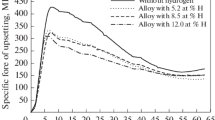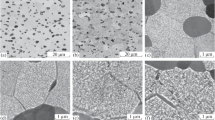Abstract
Transmission electron microscopy and microindentation have been used to study the changes in the structure, phase composition, microhardness, and elastic modulus of the Ti–24.3Al–24.8Nb–1.0Zr–1.4V–0.6Mo–0.3Si (at %) alloy based on the orthorhombic titanium aluminide Ti2AlNb alloyed with hydrogen to 8.5 at % upon aging in the temperature range of 600–700°C after quenching from 900°C. It has been detected that the alloying with hydrogen leads to a change in the morphology of precipitated orthorhombic (O) plates upon aging from a zigzag-shaped to packet morphology and at the aging temperature of 700˚С initiates the transformation of the substructure of the O plates into a polydomain one with the formation of the so-called “polysynthetic twin.” The relationship between the structural characteristics, the amounts of the arising phases, and the values of the microhardness and elastic modulus of the investigated alloys with and without hydrogen after quenching and aging has been established.




Similar content being viewed by others
REFERENCES
P. K. Sagar, D. Banerjee, K. Muraleedharan, and Y. V. R. K. Prasad, “High-temperature deformation processing of Ti–24Al–20Nb,” Metall. Mater. Trans. A 27, 2593–2604 (1996).
J. L. Yang, G. F. Wang, W. C. Zhang, W. Z. Chen, X. Y. Jiao, and K. F. Zhang, “Microstructure evolution and mechanical properties of P/M Ti–22Al–25Nb alloy during hot extrusion,” Mater. Sci. Eng., A 699, 210–216 (2017).
D. Eliezer, N. Eliaz, O. N. Senkov, and F. H. Froes, “Positive effects of hydrogen in metals,” Mater. Sci. Eng., A 280, 220–224 (2000).
A. A. Il’in, B. A. Kolachev, V. K. Nosov, and A. M. Mamonov, Hydrogen Technology of Titanium Alloys (MISiS, Moscow, 2002) [in Russian].
O. G. Khadzhieva, A. G. Illarionov, and A. A. Popov, “Influence of hydrogen on the processes of structure formation and deformability of an alloy based on orthorhombic aluminide of titanium,” Titan, No. 4, 19–24 (2012).
W.-Y. Chu and A. W. Thompson, “Effect of hydrogen as a temporary β stabilizer on microstructure and brittle fracture behavior in a titanium aluminide alloy,” Metall. Mater. Trans. A 22, 71–81 (1991).
E. Tal-Gutelmacher and D. Eliezer, “Hydrogen-assisted degradation of titanium based alloys,” Metall. Mater. Trans. A 45, 1594–1600 (2004).
P. Li, Z. Jiang, B.-G. Yuan, and K.-M. Xue, “Effect of hydrogenation on room temperature compression properties of TB8 Titanium Alloy,” J. Plast. Eng. 19, 15–18 (2012).
A. A. Popov, A. G. Illarionov, S. L. Demakov, and O. A. Elkina, “Study of phase transformations in the titanium-niobium-hydrogen system,” Int. J. Hydrogen Energy 22, 195–200 (1997).
A. A. Popov, A. G. Illarionov, S. V. Grib, S. L. Demakov, M. S. Karabanalov, and O. A. Elkina, “Phase and structural transformations in the alloy on the basis of the orthorhombic titanium aluminide,” Phys. Met. Metallogr. 106, 399–410 (2008).
L. A. Bendersky, W. J. Boettinger, and A. Roytburd, “Coherent precipitates in the b.c.c./orthorhombic two-phase field of the Ti–Al–Nb System,” Acta Metall. Mater. 39, 1959–1969 (1991).
O. G. Khadzhieva, A. G. Illarionov, and A. A. Popov, “Effect of aging on structure and properties of quenched alloy based on orthorhombic titanium aluminide Ti2AlNb,” Phys. Met. Metallogr. 115, 12–20 (2014).
A. G. Illarionov, S. V. Grib, A. A. Popov, S. L. Demakov, M. S. Karabanalov, O. G. Khadzhieva, and O. A. Elkina, “Effect of hydrogen on the formation of the structure and phase composition in the Ti2AlNb-Based Alloy”, Phys. Met. Metallogr. 109, 142–152 (2010).
O. G. Khadzhieva, A. G. Illarionov, A. A. Popov, and S. V. Grib, “Effect of hydrogen on the structure of quenched orthorhombic titanium aluminide-based alloy and phase transformations during subsequent heating,” Phys. Met. Metallogr. 114, 529–534 (2013).
W. C. Oliver and G. M. Pharr, “An improved technique for determining hardness and elastic modulus using load and displacement sensing indentation experiments,” J. Mater. Res. 7, 1564–1583 (1992).
A. L. Roitburd, “Modern state of the theory of martensitic transformations,” in Imperfections of Crystal Structure and Martensitic Transformations (Nauka, Moscow, 1972), pp. 7 [in Russian].
N. V. Kazantseva, B. A. Greenberg, S. L. Demakov, A. A. Popov, E. P. Romanov, and V. V. Rybin, “Microstructure and plastic deformation of orthorhombic Ti2AlNb aluminides: I. Formation of polydomain structure,” Phys. Met. Metallogr. 93, 269–277 (2002).
N. V. Kazantseva, S. L. Demakov, and A. A. Popov, “Microstructure and plastic deformation of orthorhombic Ti2AlNb Aluminides . III. Formation of transformation twins upon the B2 → O Phase Transformation,” Phys. Met. Metallogr. 103, 378–387 (2007).
ACKNOWLEDGMENTS
This paper was supported by the program of the leading universities of the Russian Federation in order to increase their competitiveness No. 211 of the Russian Federation Government (no. 02.А03.21.0006). The authors are grateful to Professor G. A. Salishchev (Belgorod National Research University) for carrying out the hydrogenation of the investigated samples. The work was also carried out under the state task of the Institute of Metal Physics, Ural Branch, Russian Academy of Sciences (theme “Structure” no. АААА-А18-118020190116-6).
Author information
Authors and Affiliations
Corresponding author
Additional information
Translated by O. Golosova
Rights and permissions
About this article
Cite this article
Illarionov, A.G., Khadzhieva, O.G. & Elkina, O.A. Formation of the Structure and Properties upon the Aging of a Quenched Alloy Based on Orthorhombic Titanium Aluminide Ti2AlNb Alloyed with Hydrogen. Phys. Metals Metallogr. 119, 797–801 (2018). https://doi.org/10.1134/S0031918X18040051
Received:
Published:
Issue Date:
DOI: https://doi.org/10.1134/S0031918X18040051




